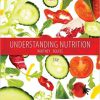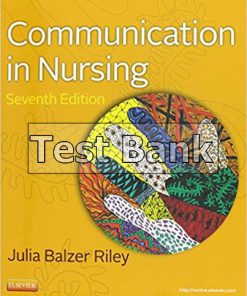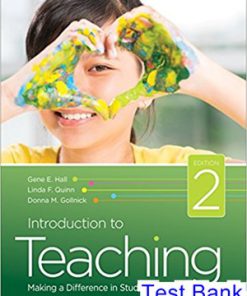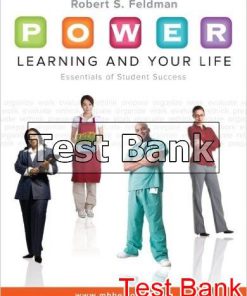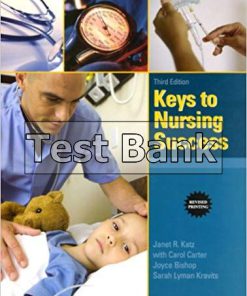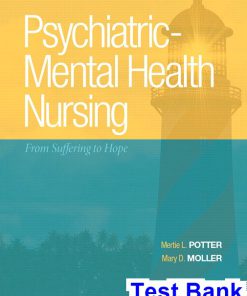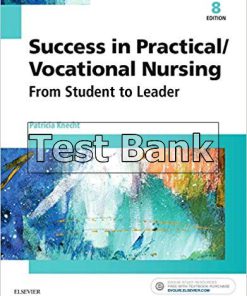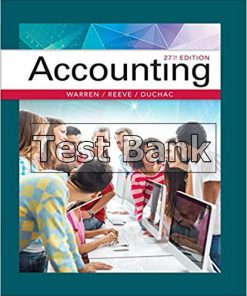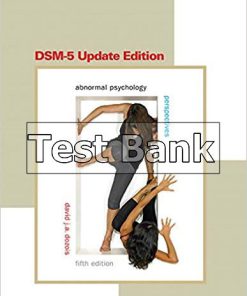Success in Practical Vocational Nursing From Student to Leader 7th Edition Hill Howlett Test Bank
$50.00 Original price was: $50.00.$26.50Current price is: $26.50.
Success in Practical Vocational Nursing From Student to Leader 7th Edition Hill Howlett Test Bank.
This is completed downloadable of Success in Practical Vocational Nursing From Student to Leader 7th Edition Hill Howlett Test Bank
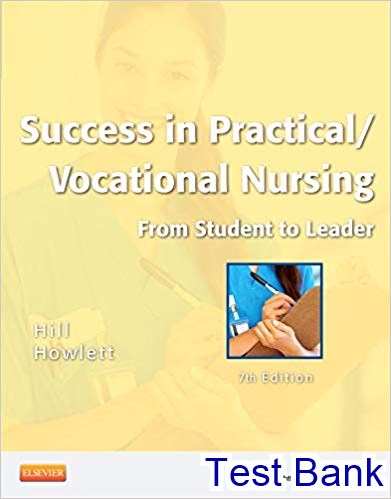
Product Details:
- ISBN-10 : 1455703354
- ISBN-13 : 978-1455703357
- Author: Signe S. Hill (Author), Helen Stephens Howlett (Author)
Part of the LPN Threads series, Success in Practical/Vocational Nursing: From Student to Leader, 7th Edition helps you develop the practical knowledge and problem-solving skills you need for a successful career as an LPN/LVN. This edition features up-to-date content that is logically organized with concepts that build on each other as you progress through the material.
Table of Content:
- Unit One The Adult Learner and the Practical/Vocational Nursing Program, 1
- chapter 1 The Adult Learner: Hints to Succeed
- Objectives
- Key Terms
- Diversity of the Adult Learner
- Try This
- The Four Generations
- Box 1-1 The Four Generations
- Box 1-2 Characteristics of the Four Generations
- Matures (The Silent Generation)
- Baby Boomers
- Generation X (Gen X)
- Generation Y (Millennials)
- Try This
- Your Generational Personality
- Critical Thinking
- Which Type of Adult Learner Am I?
- Formal and informal educational experiences
- Try This
- Informal Educational Experiences
- Geared for success
- Critical Thinking
- Reasons I Can Succeed
- Liabilities and hidden dangers
- Hidden danger shared by all adult learners
- Dangers for the traditional adult learner
- Grade Inflation
- Social Activities
- Employment
- Dangers for the returning adult learner
- Physical
- Social and Family Responsibilities
- Dangers for the recycled adult learner
- Attitude
- Critical Thinking
- Personal Needs for Improvement
- Special challenges for practical/vocational nursing students
- Learners have rights
- Responsibilities of learners
- Critical Thinking
- Responsibilities of Learners
- Teaching versus learning
- Passive Learners
- Instructors—Facilitators of Learning
- Active Learning
- Role of evaluation
- Theory Tests
- Clinical Performance Evaluations
- Professional Pointer
- Critical Thinking
- Self-Evaluation
- Critical Thinking
- Plan to Eliminate My Areas That Need Improvement
- Dealing with referrals
- Critical Thinking
- Referral to Counselor
- Other responsibilities of learners
- Get Ready for the NCLEX-PN® Examination!
- Key Points
- Additional Learning Resources
- Review Questions for the NCLEX-PN® Examination
- Alternate Format Item
- Critical Thinking Scenario
- chapter 2 Time Management: Making Time Work for You
- Objectives
- Key Terms
- Keep in Mind
- Why can’t i get organized?
- Self-test of time management
- Try This
- Self-Test of Time Management
- Benefits of time management
- Review of personal goals
- Getting organized with the nursing process
- Data collection
- Your Roles and Activities
- Your Personal Time Use
- Critical Thinking
- My Special Wish
- Before you continue
- Planning
- Arguments Against Planning
- Old Habits Die Hard
- Scheduling Time
- Setting Priorities
- Critical Thinking
- My Personal Support System
- Assigning Activities
- Box 2-1 Tasks That May Be Delegated
- Spouse/significant other
- Preschool and early school-age children (4 to 8 years)
- School-age children (9 to 12 years)
- Adolescents (13 to 18 years)
- Friends
- Relatives
- Rationale for activities chosen for:
- Assigning to Children
- Dealing with a Spouse/Significant Other
- Try This
- Semester, Weekly, and Daily Planning
- Semester planning
- Weekly planning
- Daily planning
- Professional Pointer
- Implementation
- Critical Thinking
- Return on Your Investment
- Procrastination
- Critical Thinking
- High-Priority Task That I Have Put Off
- Minitasking
- Critical Thinking
- Minitasks for a High-Priority Task
- Hints for Handling the Home or Apartment
- Evaluation
- Get Ready for the NCLEX-PN® Examination
- Key Points
- Additional Learning Resources
- Review Questions for the NCLEX-PN® Examination
- Alternate Format Item
- Critical Thinking Scenarios
- Amy, continued …
- chapter 3 Learning Methods and Skills: How Do You Learn?
- Objectives
- Key Terms
- Keep in Mind
- Try This
- Brain dominance
- Right and left sides of the cerebrum
- Right-brain-dominant individuals
- Left-brain-dominant individuals
- Thinking style
- Learning styles
- Perceptual learning styles
- Table 3-1 Left and Right Hemispheres of the Cerebrum
- Try This
- Self-Evaluation of Sensory Learning Style Directions
- Key
- Critical Thinking
- Summarizing Your Learning Styles
- Perceptual learning style preference
- Critical Thinking
- Professional Pointer
- Visual Learner
- Auditory Learner
- Kinesthetic/Tactual Learner
- Try This
- Categories of multiple intelligences
- Identifying and using the intelligences
- Linguistic learner (the word player)
- Logical/mathematical learner (the questioner)
- Spatial learner (the visualizer)
- Musical learner (the music lover)
- Bodily/kinesthetic learner (the mover)
- Interpersonal learner (the socializer)
- Intrapersonal learner (the individual)
- Critical Thinking
- Implementing Suggestions
- Professional Pointer
- How we learn
- Mapping (concept map)
- Box 3-1 Hints for Note Making: Mapping Method
- Visual strategies to enhance understanding
- Draw Idea Sketches
- Use Color in Whatever Form of Note Making You Use
- Make Your Own Diagram as You Read
- Figure 3-1 Clustering.
- Figure 3-2 Idea sketch: Lanoxin (digoxin).
- Engage in Mental Imagery
- Box 3-2 Mental Images Depicting the Function of Insulin: I Am Insulin—a Job Description
- Critical Thinking
- Increasing Understanding of Concepts
- Undependable memory and learning system
- Possible Behaviors
- Some suggestions for the student with ADHD
- Try This
- More barriers to learning
- Racial bias in textbooks
- Try This
- Text/e-Book Authority
- Critical Thinking
- Text/e-book Authority
- Inability to understand (comprehend) content
- Critical Thinking
- Putting it all together
- Get Ready for the NCLEX-PN® Examination
- Key Points
- Additional Learning Resources
- Review Questions for the NCLEX-PN® Examination
- Alternate Format Item
- Critical Thinking Scenarios
- Scenario 1
- Scenario 2
- chapter 4 Using Your Methods and Skills: Studying and Testing
- Objectives
- Key Terms
- Keep in Mind
- General hints for learners
- Concentration
- External Distractions
- Personal Study Area
- Lighting
- Background Noise
- Internet and Social Networking
- Your Peers
- Try This
- Personal Distractions
- Internal Distractions
- Complaints of Mental Fatigue
- Daydreaming
- Try This
- Daydreaming
- Listening/viewing
- The Active and Passive Listener/Viewer
- Try This
- Active Versus Passive Listener/Viewer
- Box 4-1 Hints for Active Listening/Viewing in Classes
- Note Making Versus Note Taking
- Note Making Hints
- Box 4-2 Hints for Note Making
- How to understand (comprehend) information
- Reading Assignments
- Try This
- Reading Habit Evaluation
- Reading Effectively
- Critical Thinking
- Improving Reading Habits
- Remembering and forgetting
- From temporary to permanent memory by way of a neural trace
- Memory aids
- Successful test taking
- Preparing for the test
- Taking the test
- Reviewing your tests
- Try This
- How Well Do You Follow Directions?
- Reducing anxiety before testing
- Try This
- Relax!
- Hints for specific questions
- Multiple-Choice Questions
- Box 4-3 Multiple-Choice Test Hints
- Try This
- Multiple-Choice Questions
- Answer to Multiple-Choice Questions
- Alternate Item Formats
- Fill-in-the-Blank
- Try This
- Fill-in-the-Blank Questions
- Multiple-Response
- Try This
- Multiple-Response Questions
- Prioritizing
- Try This
- Prioritizing Question
- Get Ready for the NCLEX-PN® Examination
- Key Points
- Additional Learning Resources
- Review Questions for the NCLEX-PN® Examination
- Alternate Format Item
- Critical Thinking Scenario
- chapter 5 Learning During School: Using Available Resources
- Objectives
- Key Terms
- Keep in Mind
- Your School’s Learning Resource Center
- Different student skill levels and different resources of the learning resource center
- Box 5-1 Checklist of Tasks Needed to Fully Use Learning Resource Center General Resources and Technology
- Box 5-2 Checklist of Tasks Needed to Fully Use LRC Nursing Resources and Technology
- Try This
- Checklist—General and Nursing Resources and Technology
- Where to start
- Critical Thinking
- Filling in the Gaps in My Learning Resource Center Knowledge
- General Information About Resources of the Library
- Librarian
- Circulation Desk
- Online Catalog
- Locating in-house resources
- The Stacks
- Reference Materials
- Interlibrary Loan Services
- Vertical Files (Pamphlet Files)
- Professional Journals
- Try This
- Nursing Periodicals
- Articles
- Magazines and Newspapers
- Responsible use of learning strategies
- Face-to-Face Class
- Lectures/minilectures
- Lecture-discussion
- Box 5-3 Learning Strategy: Discussion Buddy
- Box 5-4 Hints for a Discussion Class
- Cooperative Learning
- Box 5-5 Verbal Cues for Key Ideas in Minilectures, Discussions, and Online Activities
- Distance Learning
- Box 5-6 Technology Courtesy for Learning Activities
- Technology use during learning activities
- Other Learning Resources
- Syllabus and course outlines
- Study groups
- Tutoring
- Nursing skills lab
- Study skills lab
- Critical Thinking
- No Time for Tutoring or the Skills Center
- Audiovisual materials
- Internet
- Try This
- Peer Assistance with Computer/Internet
- Mobile Devices
- Box 5-7 Guidelines for Gathering Internet Information
- Computer-aided instruction
- Simulation
- Staying Current in Practical/Vocational Nursing
- Periodicals
- Print Periodical Indexes
- Try This
- Using the CINAHL® Print Edition
- Figure 5-1 Explanation of an entry from the printed Cumulative Index to Nursing and Allied Health Literature.
- Digital Periodical Databases
- Nursing organizations
- Community resources
- Guest speakers
- Social Media (Electronic Media) and Social Networking
- Professional Pointer
- Try This
- Social Media Policies
- Get Ready for the NCLEX-PN® Examination
- Key Points
- Additional Learning Resources
- Review Questions for the NCLEX-PN® Examination
- Alternate Format Item
- Critical Thinking Scenario
- chapter 6 Personal Health Promotion: A Role Model for Patients
- Objectives
- Key Terms
- Keep in Mind
- New Look at Nutrition and Health
- 2010 Dietary Guidelines for Americans
- Introduction to the MyPlate Icon
- Figure 6-1 MyPlate. The 2010 MyPlate recommends the following: Avoid oversize portions; make half your plate vegetables and fruits; make at least half your grains whole grain; protein is the smallest part of the plate; switch to fat-free or low-fat (1%) milk; look for lower-sodium soup, bread, and frozen meals; and drink water instead of sugary drinks.
- How-To Messages to Guide Healthy Eating
- Try This
- Making Good Food Choices
- Professional Pointer
- Making Time for Physical Activity
- Try This
- Making Room for Exercise
- Moderate physical activity
- Start the day with a stretch and flex
- Table 6-1 Examples of Moderate Activity
- Making minimal effort pay off at work
- Critical Thinking
- Making Exercise a Daily Activity
- Back Injuries in Nursing: What We Did Not Know
- Box 6-1 The 16 Most Physically Stressful Tasks for Nurses
- Preventing injuries
- Critical Thinking
- Preventing Injury in the Clinical Area
- Health Care–Associated Infections (HAIs): An Issue of Safety for the Patient, your Family and You
- Try This
- Differentiating Between Burnout and Stress
- Table 6-2 Stress Versus Burnout
- Try This
- Your Life Choices and Burnout
- Preventing burnout
- Empathy Versus Sympathy
- Detached Way of Evaluating Self
- Time Management
- Humor
- Maintaining Nursing Skills
- Critical Thinking
- Where Am I Headed?
- Secondary Traumatic Stress
- Recognizing signs of secondary traumatic stress
- Prevention
- Chemically Dependent Nurses
- Box 6-2 Telltale Signs of Chemical Dependency in Nurses
- Critical Thinking
- How Am I Doing?
- Codependency: A Pathologic Need
- Try This
- Codependency: A Pathologic Need
- Critical Thinking
- Codependency: A Bothersome Behavior
- Dealing with Negative Stress: Some Ideas
- Try This
- Avoid Negative Stress
- Table 6-3 Some Codependent Characteristics and Behaviors
- Try This
- Find a Good Role Model
- Relaxation
- Meditation
- Imagery
- Box 6-3 Imagery: Relieving Anxiety
- Brief relaxation
- Critical Thinking
- Personal Stress Management
- Sleep
- Box 6-4 Brief Relaxation
- Try This
- Get Enough Sleep
- Get Ready for the NCLEX-PN® Examination
- Key Points
- Additional Learning Resources
- Review Questions for the NCLEX-PN® Examination
- Alternate Format Item
- Critical Thinking Scenarios
- Scenario 1: Patients and Family Members Can Help
- Scenario 2: Relieving Test Anxiety
- Unit One Building Blocks for Your Career, 71
- chapter 7 How Practical/Vocational Nursing Evolved: 1836 to the Present
- Objectives
- Key Terms
- Keep in Mind
- Modern practical nurses
- Table 7-1 Practical Nursing Milestones
- First school of nursing (1836)
- Florence nightingale (1820–1910)
- Crimean war 1853—1865
- Figure 7-1 Florence Nightingale ministering to soldiers at Scutari (lithograph).
- Mary seacole; honored for her work
- Death rate drops; nightingale decorated
- Box 7-1 Santa Filomena
- Nightingale establishes first school of nursing in england
- Nightingale’S core belief about nursing
- Critical Thinking
- Nightingale Pledge and Nursing
- Nightingale museum on the site of her school of nursing
- Critical Thinking
- Nursing—Vocation or Profession?
- Early training schools in america
- Civil war (1861—1865)
- Figure 7-2 Nursing in the Civil War (wood engraving).
- Clara barton
- Critical Thinking
- Formal training: practical nursing
- Critical Thinking
- Nursing in the home
- From home to public health nursing
- Figure 7-3 Public health nursing follow-up visits.
- Twentieth century
- Mississippi: first to license practical nurses
- Critical Thinking
- State License
- World war I nurses 1914—1918
- Figure 7-4 The Sacred Twenty: the first 20 Navy nurses appointed in 1908.
- Canadian Nurses in World War I
- Smith hughes act of 1917
- Nurses return home: acute nursing shortage follows world war I
- Depression of the 1930s
- World war II 1939—1945
- Figure 7-5 Eighth Evacuation Hospital situated in the auditorium of a former Italian school, Casablanca, French Morocco.
- Practical nursing responsibilities increase after world war II
- Practical nursing duties outlined
- RN and LPN tasks differentiated
- The korean conflict (also known as united nations police action or the second indochina war) 1950—1953
- Figure 7-6 In the Korean conflict, a wounded soldier receives medical attention while lying on a stretcher. A soldier is being helped up the hill by another soldier, while a third soldier looks on.
- RNS react
- Public law 911
- The vietnam war 1961—1973
- Figure 7-7 The American Soldier, 1975. In the foreground, as concerned relatives look on, an Army nurse checks an injured Vietnamese citizen. The scene is typical of many long evenings in tents set up as emergency medical stations on Guam, the first stop for the refugees.
- Critical Thinking
- Preventing Posttraumatic Stress Disorder
- American nurses association movement toward two levels of nursing
- Afghan war (also known as Operation Enduring Freedom) 2001-present and the iraq war (also known as Operation Iraqi Freedom, Second Gulf War and more recently Operation New Dawn) 2003—DECEMBER 2011
- Figure 7-8 Barbara Smith, U.S. Army Garrison Wiesbaden occupational health nurse, leads a combat lifesaver training course in Afghanistan.
- Figure 7-9 Commander Paul M. Barfknecht, emergency nurse, Shock Trauma Platoon, Health Service and Support Company, Combat Logistics Battalion 4, simulates pumping air into a patient during a mass casualty training exercise, March 2, 2009, at Camp Baharia, Iraq.
- Try This
- American medical association moves to ease nursing shortage
- Unlicensed assistive personnel
- First computerized testing: NCLEX-PN®
- Long-term CARE certification
- Twenty-first century
- Important influences in nursing history
- You have come a long way!
- Table 7-2 People and Events in Nursing History
- Box 7-2 Hospital Nursing 1887
- Get Ready for the NCLEX-PN® Examination
- Key Points
- Additional Learning Resources
- Review Questions for the NCLEX-PN® Examination
- Alternate Format Item
- Critical Thinking Scenarios
- Scenario 1
- Scenario 2
- chapter 8 Critical Thinking: A Lifelong Journey
- Objectives
- Key Terms
- Keep in Mind
- Overview of critical thinking
- Professional Pointer
- Ways of thinking
- Definition of applied critical thinking
- Try This
- Survey of your Current Level of Critical Thinking
- Critical Thinking
- Make a Personal Plan
- Critical thinking and practical/vocational nursing
- Box 8-1 Ways to Challenge Yourself to Think Critically
- What you need to think critically
- Factors that Influence Critical Thinking
- Try This
- Attitude Evaluation—My Attitude
- Critical Thinking
- Attitudes to Work On
- Additional factors that influence critical thinking
- Critical thinking and the nclex-pn®
- Making it work for you
- Where to go from here
- Get Ready for the NCLEX-PN® Examination
- Key Points
- Additional Learning Resources
- Review Questions for the NCLEX-PN® Examination
- Alternate Format Item
- Critical Thinking Scenarios
- Scenario 1
- Scenario 2
- chapter 9 The Nursing Process: Your Role
- Objectives
- Key Terms
- Keep in Mind
- The nursing process: the 1950s
- The nursing process: the 1970s to the 1990s
- Try This
- The Nurse Practice Act
- The nursing process: 2000 and beyond
- What differentiates your role from the RN role
- Developing your plan of care for assigned patients
- Steps of the nursing process
- Step 1: data collection
- Systematic Way of Gathering Data
- Verify the Information
- Communicate Information to Appropriate Health Care Team Members
- Other Aspects of Data Collection
- Data Collection Continues
- Box 9-1 Examples of Practical/Vocational Nurse Data Collection
- Accuracy in Data Collection
- Introduce Yourself
- Asking Questions
- Barriers in Data Collection
- Step 2: planning
- Assisting the RN to Develop the Nursing Diagnosis
- Try This
- Assisting During Planning
- Realistic, Useful Nursing Care Plans
- Table 9-1 Example of a Student Assignment Sheet and Patient Care Plan
- Critical Thinking
- The Seven Survival Needs
- Possible answers:
- Assisting the RN to Develop Outcomes
- Strengths
- Goals and Outcomes
- Assisting the RN to Develop Nursing Interventions
- Table 9-2 Nursing Diagnosis, Nursing Problem, Outcome, and Interventions
- Care Plans Vary
- Maintaining Patient Safety
- Documenting the Care Plan
- Step 3: implementation
- Nursing Action
- Maintaining Patient Safety
- Initiating Teaching That Is Within Your Role and Supports the RN’s Teaching
- Reporting and Documenting
- Try This
- Implementing the Plan of Care
- The Difference Between LPN/LVN and SPN/SVN Responsibility
- Step 4: evaluation
- Assist in Determining Patient Progress Toward Meeting Desired Patient Goals/Outcomes
- Communicate Findings
- Table 9-3 Data Collection, Outcome, and Evaluation
- Try This
- Evaluating Patient Progress
- Where are we now in the nursing process?
- Nursing interventions classification
- Nursing outcomes classification
- Linking North American Nursing Diagnosis Association International, Nursing Interventions Classification, and Nursing Outcomes Classification
- Figure 9-1 Concept map of a client with chronic cancer pain.
- Get Ready for the NCLEX-PN® Examination
- Key Points
- Additional Learning Resources
- Review Questions for the NCLEX-PN® Examination
- Alternate Format Item
- Critical Thinking Scenarios
- Scenario 1
- Scenario 2
- chapter 10 Nursing Theory, Research, and Evidence-Based Practice
- Objectives
- Key Terms
- Keep in Mind
- Nursing theories
- Rationale for Theories
- Florence Nightingale: The First Nursing Theorist
- Abraham maslow’s Human needs theory
- Applying Maslow’s Human Needs Theory to the Nursing Process
- Orem’s self-care deficit theory
- Figure 10-1 A. Maslow’s Hierarchy of Human Needs. B. Evolving Hierarchy of Needs adapted by nursing.
- Madeline Leininger’s Culture Care Theory
- Hildegard Peplau’s Interpersonal Relations Theory
- Rosenstock’s health belief theory
- Sister Callista Roy’s Adaptation Model
- Jean Watson’s Theory of Human Care
- Nursing Research
- Evidence-Based Practice
- Background of the Evidence-Based Practice Movement
- How Best Evidence for Practice Guidelines Is Determined
- Box 10-1 Systematic Reviews Used to Develop EBP Guidelines
- PubMed (http://pubmed.gov)
- Cumulative Index of Nursing and Allied Health Literature (CINAHL)
- Cochrane Reviews (http://www.cochrane.org/cochrane-reviews)
- Agency for Healthcare Research and Quality (AHRQ) (http://www.ahrq.gov/)
- The Joanna Briggs Institute (JBI) (http://www.joannabriggs.edu.au/)
- Try This
- Evidence-Based Practice (EBP) in Nursing
- Elements of Evidence-Based Practice
- The Nurse’s Role
- Figure 10-2 The triangle of evidence-based practice.
- The Practical/Vocational Nurse’s Role in Evidence-Based Practice
- Get Ready for the NCLEX-PN® Examination
- Key Points
- Additional Learning Resources
- Review Questions for the NCLEX-PN® Examination
- Alternate Format Item
- Critical Thinking Scenario
- chapter 11 Ethics Applied to Nursing: Personal Versus Professional Ethics
- Objectives
- Key Terms
- Keep in Mind
- Critical Thinking
- Description and scope of ethics
- Critical Thinking
- Morals and values
- Comparison of legal aspects of nursing and ethics
- Nursing ethics
- Ethical codes of the national association for practical nurse education and the service and national federation of licensed practical nurses
- Table 11-1 Comparison of Legal Aspects and Nursing Ethics
- Try This
- Ethical Issues and Your Nurse Practice Act
- Your personal code of ethics
- Critical Thinking
- Personal Values
- Roots of nursing ethics
- What changed?
- Ethical decisions in health care
- Ethics committees
- Western secular belief system
- Critical Thinking
- Personal Beliefs That May Affect Medical Decisions
- Ethical responsibilities of nurses
- Principles of ethics
- Nonmaleficence (do no harm)
- Try This
- Procedures and Their Effects
- Beneficence (do good)
- Critical Thinking
- Ethical Obligations
- Autonomy (free to choose)
- Role of Privacy in Autonomy
- Role of Culture, Religion, and Personal Values in Autonomy
- Fidelity (be true)
- Justice (fair to all)
- Critical Thinking
- Role of beneficent paternalism
- Paternalism and women’s health
- Critical Thinking
- Do I Respond Differently to Male and Female Patients?
- Get Ready for the NCLEX-PN® Examination
- Key Points
- Additional Learning Resources
- Review Questions for the NCLEX-PN® Examination
- Alternate Format Item
- Critical Thinking Scenarios
- Scenario 1
- Scenario 2
- chapter 12 Nursing and the Law: What Are the Rules?
- Objectives
- Key Terms
- Keep in Mind
- Nurse practice act
- Basic terminology
- Content of nurse practice acts
- Try This
- Get Familiar with Your Scope of Practice in the State’s Nurse Practice Act
- State board of nursing
- Functions of the board
- Box 12-1 Common Board of Nursing Functions
- Disciplinary responsibility of the board
- Box 12-2 Eight Categories of Disciplinary Actions Taken Against Nurses
- Disciplinary process and action
- Nursing licensure
- Working in other states
- Box 12-3 Steps for Disciplinary Action
- Try This
- Compact States and the Nurse Practice Act
- Try This
- Interstate Agreement
- Verification of licensure
- Unlicensed assistive personnel
- Nursing standard of care
- Keep in Mind
- How the law affects licensed practical nurses and licensed vocational nurses
- Common law versus statutory law
- Box 12-4 Resources for the Nursing Standard of Care
- Criminal versus civil action
- Intentional torts
- Assault and Battery
- Table 12-1 Comparison of Two Basic Classifications of Law
- False Imprisonment and Use of Restraints
- Defamation
- Physical and Emotional Abuse
- Unintentional torts
- Negligence
- Malpractice (professional negligence)
- Malpractice insurance for nurses
- Try This
- Malpractice Coverage
- Box 12-5 Some Common Sources of Malpractice
- Box 12-6 Reasons for Your Own Malpractice Insurance
- Four elements needed to prove negligence
- Critical Thinking
- Box 12-7 Four Elements Needed to Prove Negligence
- Steps for bringing legal action
- Depositions
- Attorney procedures
- Box 12-8 Steps for Bringing a Legal Action by a Patient
- Giving testimony
- Liability
- Kinds of liability
- Common causes of nursing liability
- Professional Pointer
- Responsibility and accountability in nursing
- Liability of student nurses and instructors
- Box 12-9 SPN/SVN Responsibilities for Patient Care
- Functioning beyond the scope of practice and experience
- Specific patient situations
- Box 12-10 Possible Responses When Asked to Perform Beyond Your Scope of Practice
- Privacy and confidentiality
- Information that must be revealed
- Patients’ rights
- Box 12-11 Patient Information That Must Be Revealed
- Box 12-12 The Patient Care Partnership Recommendations: What to Expect During a Hospital Stay
- Try This
- Patients’ Rights
- Health insurance portability and accountability act
- Box 12-13 Basic Health Insurance Portability and Accountability Act Terminology
- Basics of the Health Insurance Portability and Accountability Act
- Critical Thinking
- Patient Privacy
- The Notice of Privacy Practices
- What the Notice of Privacy Practices Addresses
- Critical Thinking
- Medical Records
- Concerns That the Health Insurance Portability and Accountability Act Does Not Address
- Try This
- Maintain Patient Confidentiality
- Box 12-14 Additional Concerns Not Addressed by HIPAA*
- Patient competency
- Patient’s right to consent
- General (Implied) Consent
- Critical Thinking
- Resolve Consent Issues
- Informed Consent
- Authorized Consent
- End-of-life issues
- Patient self-determination act
- Advance directives
- Living Will
- Durable Medical Power of Attorney (Advanced Health Care Directive)
- Try This
- Legal Directives
- Do-not-resuscitate order
- Removal of life support systems
- Physician-assisted suicide and euthanasia
- Table 12-2 Active and Passive Euthanasia
- Oregon Death With Dignity Act
- Try This
- Terminally Ill Patients
- Organ donation
- End-of-life care
- Good samaritan act
- Try This
- Good Samaritan Act
- Get Ready for the NCLEX-PN® Examination
- Key Points
- Additional Learning Resources
- Review Questions for the NCLEX-PN® Examination
- Alternate Format Item
- Critical Thinking Scenarios
- Scenario 1
- Scenario 2
- Unit One Patients and Coworkers, 149
- chapter 13 Straightforward Communication: Instructors, Coworkers, and Patients
- Objectives
- Key Terms
- Keep in Mind
- Communication Process
- Try This
- Communicating with Your Patient
- One-way versus two-way communication
- Factors that affect communication
- Types of Communication
- Verbal communication
- Figure 13-1 Communication.
- Nonverbal communication
- Try This
- Appropriate Dress Code and Behavior
- Affective communication
- Critical Thinking
- Affective Communication
- Communication Strategies
- Active listening
- Active listening behaviors
- Types of questions
- Nurse–patient communication evaluation
- Try This
- Self-Evaluation of Personal Characteristics
- Critical Thinking
- A Plan for Change
- Blocks to Communication
- Avoiding blocks
- Male/Female Differences
- Conversation
- Head movements
- Smiling
- Posture
- Cultural Differences
- Try This
- Cultural Differences
- Role Changes for the Patient
- Critical Thinking
- Immediate Concerns upon Hospitalization
- Professional Pointer
- It begins with “hello, my name is….”
- Nursing jargon
- Fear of the unknown
- Personal factors
- Environmental factors
- Communicating with Instructors and Staff
- Respect
- Trust
- Honesty
- Empathy
- Sensitivity
- Humor
- Knowledge
- Patience
- Commitment
- Self-esteem, thoughts, and straightforward communication
- Situation, background, assessment, recommendation
- SBAR for the Shift Report
- Try This
- Using the SBAR Method
- Life Span Communication
- Infant
- Preschool
- School age
- Teenage
- Adult
- Elderly
- Conflict Resolution
- Try This
- Resolving Conflicts
- Electronic Communication
- Cell phones and text messaging
- Box 13-1 Email Etiquette
- Get Ready for the NCLEX-PN® Examination
- Key Points
- Additional Learning Resources
- Review Questions for the NCLEX-PN® Examination
- Alternate Format Item
- Critical Thinking Scenarios
- Scenario 1
- Scenario 2
- chapter 14 Assertiveness: Your Responsibility
- Objectives
- Key Terms
- Keep in Mind
- Critical Thinking
- Personal Expectations
- Nonassertive (passive) behavior
- Try This
- Nonassertive Behavior
- Critical Thinking
- Nonassertive Behavior
- Aggressive behavior
- Try This
- Aggressive Behavior
- Critical Thinking
- Aggressive Behavior
- Assertive behavior
- Try This
- Identify Assertiveness
- Negative interactions: using coping mechanisms
- Figure 14-1 A vicious circle showing a negative interaction from an unresolved incident between the patient and the nurse.
- Critical Thinking
- Negative Interactions
- Try This
- Identify If Behavior Is Passive, Aggressive, or Assertive
- Gossip hurts
- Critical Thinking
- More Damaging Interactions
- Guidelines for moving toward assertiveness
- Problem-solving process
- Box 14-1 Myself
- Figure 14-2 A cycle of unresolved patient issues.
- Critical Thinking
- Plan for Living
- Problem-solving steps
- Step 1: Define the Problem
- Critical Thinking
- Gains and Losses
- Try This
- Keep a Daily Journal
- Step 2: Decide on a Goal
- Critical Thinking
- Defining the Problem
- Sample
- Critical Thinking
- Deciding on a Goal
- Sample
- Step 3: Choose Alternatives
- Critical Thinking
- Personal Alternatives
- Sample
- Step 4: Try Out the Alternatives
- Try This
- Celebrate Attaining Your Goals
- Step 5: Evaluate the Effectiveness of Your Approach
- Try This
- Review Your Journal
- Step 6: Repeat the Process If the Solution Is Not Effective
- Cultural differences: manipulation
- Negative manipulative interactions
- Aggressiveness and work-related issues
- Assault
- Box 14-2 OSHA National Guidelines for Deterring Violence
- Try This
- The American Nurses Association Bill of Rights
- Contributing factors
- Personal Factors
- Workplace Practices
- Environmental Factors
- Risk Diagnosis
- Try This
- Evaluate Protection Against Potential Dangers
- Critical Thinking
- Preventing Possible Assault
- Professional Pointer
- Employee violence
- Signs of Workplace Violence
- Prevention of Workplace Violence
- Box 14-3 Some General Safeguards for Preventing Workplace Violence
- Critical Thinking
- Personal Violence Prevention Plan
- Sexual harassment
- Try This
- Sexual Harassment Policy
- Critical Thinking
- Personal Plans for Safety
- Counseling and filing charges
- Lateral Violence
- Insidious Aggression
- Critical Thinking
- Get Ready for the NCLEX-PN® Examination
- Key Points
- Additional Learning Resources
- Review Questions for the NCLEX-PN® Examination
- Alternate Format Item
- Critical Thinking Scenarios
- Scenario 1
- Scenario 2
- chapter 15 The Health Care Team: Where the Practical/Vocational Nurse Fits In
- Objectives
- Key Terms
- Keep in Mind
- Who is responsible for Mrs. brown’s discharge?
- Mrs. Brown’s emergency care
- The surgical experience
- Postanesthesia care unit
- Intensive care: a time for close observation
- Surgical floor: an eye to discharge
- Extended-care unit: on the road to rehabilitation
- Critical Thinking
- Who Is Responsible for Mrs. Brown’s Recovery?
- Health care team
- What is nursing?
- Nursing’s place on the health care team
- Diversity in educational preparation of nurses
- Registered nurses
- Education
- Associate Degree Nursing Program
- Diploma Program
- Bachelor’s Nursing Program
- Role of Registered Nurses
- Independent Role of the Registered Nurse
- Interdependent Role of the Registered Nurse
- Education In Addition to the Basic Nursing Programs for Registered Nurses
- BSN Completion Program
- Accelerated BSN Program
- Master of Nursing Programs
- Certification
- Advanced Practice Registered Nurse
- Doctoral Nursing Education
- Nursing Management, Leadership, and Executive Roles
- Try This
- Get to Know the Nursing Team
- Practical/vocational nurses
- Background
- Box 15-1 Nursing Management and Executive Roles
- Education
- Role of Practical/Vocational Nurses
- Critical Thinking
- The LPN/LVN Role in Assisting with the Nursing Process
- Expanded Role of Practical/Vocational Nurses
- Table 15-1 Differences Between the Roles of RNs and LPNs/LVNs
- Critical Thinking
- Expanded Role of the LPN/LVN
- Student nurses
- Nursing assistants
- Keep in Mind
- Diversity of Age for Coworkers on the Nursing Team
- Box 15-2 The Four Generations of Nursing Teams
- Matures
- Boomers—77 million in the workforce
- Generation X—44 million in the workforce
- Generation Y—70 million in the workforce
- Unlicensed assistive personnel
- Clerk receptionists
- Unit managers
- Critical Thinking
- Know Your Health Care Team
- Delivery of nursing care in acute care settings
- Case method
- Functional nursing
- Team nursing
- Primary nursing
- Nursing case management
- Skill mix
- Patient-centered care—a philosophy
- Figure 15-1 Clinical pathway: postanesthesia care unit coordinated care track for pediatric patient.
- The hidden nursing shortage
- Box 15-3 Some Causes of the Hidden Nursing Shortage
- Get Ready for the NCLEX-PN® Examination
- Key Points
- Additional Learning Resources
- Review Questions for the NCLEX-PN® Examination
- Alternate Format Item
- Critical Thinking Scenarios
- Scenario 1
- Scenario 2
- chapter 16 Cultural Uniqueness, Sensitivity, and Competence
- Objectives
- Key Terms
- Keep in Mind
- Definition of culture
- Characteristics of culture
- Danger: ethnocentrism, prejudice, and discrimination
- Avoiding false assumptions
- Critical Thinking
- Example of a False Assumption
- Think like an anthropologist!
- Knowing yourself
- What makes you unique?
- Try This
- What Makes You Unique?
- How many hats do you wear?
- Try This
- Identifying the Roles You Play in Your Life
- Category 1: Economic Status Role
- Category 2: Political Role
- Category 3: Racial or Ethnic Role
- Category 4: Social Role
- Category 5: Work Role
- Try This
- Who Am I Based on My Roles?
- What we share in common
- Try This
- What We Have in Common
- Basic daily needs: another commonality
- Personal Care and Hygiene
- Professional Pointer
- Sleep and Rest
- Nutrition and Fluids
- Elimination
- Body Alignment and Activity
- Environment
- Emotional and Spiritual Support
- Diversion and Recreation
- Mental Hygiene
- Try This
- Basic Daily Needs
- Knowing others: cultural diversity
- Importance of cultural diversity
- Philosophy of Individual Worth
- Professional Pointer
- Learning about cultural diversity
- How to Begin
- Areas of cultural diversity
- Family Structure
- Try This
- Cultural Patterns: Family
- Food Preferences
- Try This
- Cultural Patterns: Food
- Religious Beliefs
- Try This
- Cultural Patterns: Religion
- Concept of Time
- Try This
- Cultural Patterns: Time
- Communication
- Forms of Hellos and Good-byes
- Appropriateness of the Situation
- Confidentiality
- Emotions and Feelings and Their Expression
- Pain Expression
- Tempo of Conversation
- Meaning of Silence
- Critical Thinking
- Stoic Behavior in Patients
- Try This
- Cultural Patterns: Communication
- Box 16-1 Hints for Using Interpreters and Other Language Resources
- Educational Background
- Try This
- Cultural Patterns: Education
- Economic Level
- Try This
- Cultural Patterns: Economic Level
- Wellness and Illness Beliefs and Practices
- Preventing Illness
- Curing Illness
- Complementary and Alternative Medicine
- Modesty
- Mental Illness
- Try This
- Cultural Patterns: Wellness Beliefs and Practices
- Pregnancy and Birth Beliefs and Practices
- Try This
- Cultural Patterns: Pregnancy and Birth Beliefs and Practices
- Terminal Illness and Death Beliefs and Practices
- Try This
- Cultural Patterns: Terminal Illness and Death Beliefs and Practices
- Try This
- Areas of Cultural Diversity
- Increasing your knowledge of culturally diverse groups
- Categories of major health belief systems
- Box 16-2 Biomedical Health Belief
- Cause of Disease
- How Disease Is Diagnosed
- How Disease Is Treated
- Who Cures the Disease
- How Disease Is Prevented
- Box 16-3 Personalistic Health Belief
- Cause of Disease
- How Disease Is Diagnosed
- Who Cures the Disease
- How Disease Is Treated
- How Disease Is Prevented
- Box 16-4 Naturalistic Health Belief
- Cause of Disease
- How Disease Is Diagnosed
- How Disease Is Treated
- Who Cures the Disease
- How Disease Is Prevented
- Diversity profiles of predominant cultural groups in the united states
- Developing cultural competence in health care situations
- Box 16-5 Diversity Profiles of Predominant Cultural Groups in the United States
- African Americans
- Hmong
- Hispanics
- American Indians/Alaskan Natives
- Arab Americans
- Notes
- Identify your agency’s cultural groups
- Try This
- Your Area’s Cultural Groups
- Modify your work setting
- Care planning for culturally diverse patients in your service area
- Box 16-6 Modifying the Environment to Accommodate Culturally Diverse Patients
- Box 16-7 Sample Data-Gathering Sheet Using a Traditional Hmong Patient as an Example
- Patient: Culture: Traditional Hmong
- Box 16-8 How to Avoid Stereotyping Culturally Diverse Patients
- Adapting plans of care for culturally diverse patients
- Box 16-9 Negotiating Treatment Plans with the Patient
- Situation
- Cultural health beliefs in this situation
- Negotiating treatment plans
- Box 16-10 Preserving the Beliefs and Practices That Are Helpful to the Patient
- Situation
- Cultural Health Beliefs in this Situation
- Preserving the Beliefs and Practices That Are Helpful to the Patient
- Box 16-11 Repatterning Harmful Practices
- Situation
- Cultural Health Beliefs in this Situation
- Repatterning the Patient’s Harmful Practices
- Get Ready for the NCLEX-PN® Examination
- Key Points
- Additional Learning Resources
- Review Questions for the NCLEX-PN® Examination
- Alternate Format Item
- Critical Thinking Scenario
- chapter 17 Spiritual Needs, Spiritual Caring, and Religious Differences
- Objectives
- Key Terms
- Keep in Mind
- Spirituality and religion
- Spiritual versus emotional dimension
- Importance of spiritual care
- Who needs spiritual care?
- Gathering data for spiritual issues
- Try This
- Your Personal Spirituality
- Critical Thinking
- My Spiritual Sensitivity
- Meeting the spiritual needs of patients and their families
- Pastoral care team
- Box 17-1 Spiritual Care Interventions
- How patients meet spiritual needs
- Patients’ spiritual practices
- Try This
- My Spiritual Practices
- Religion and the patient
- Professional Pointer
- Value of rituals and practices
- The patient and prayer
- The religious american
- Religion in the united states
- Avoiding false assumptions and stereotypes
- Box 17-2 Gathering Data for Religious Beliefs and Practices of Patients
- Western and middle eastern religions in the united states and canada
- Judaism
- Figure 17-1 Star of David. This is a generally recognized symbol of Judaism.
- Christianity
- General Beliefs of Christians
- The Bible
- Figure 17-2 The cross represents the instrument of the crucifixion of Jesus Christ.
- Box 17-3 Beliefs, Practices, and Nursing Interventions for Jewish Patients
- General
- Beliefs and Practices
- Nursing Interventions
- Observation of sabbath
- Nursing Interventions
- Observance of dietary rules (kosher diet)
- Beliefs and Practices
- Nursing Interventions
- Dying jewish patient
- Beliefs and Practices
- Nursing Interventions
- Baptism
- Box 17-4 Procedure for Baptism
- Nursing Interventions
- Box 17-5 Beliefs, Practices, and Nursing Interventions for Catholic Patients
- Roman catholic (western)
- Baptism Beliefs
- Nursing Interventions
- Communion Beliefs
- Nursing Interventions
- Nursing Interventions
- Dietary Restrictions
- Nursing Interventions
- Sexuality
- Dying Catholic Patient
- Nursing Interventions
- Eastern orthodox churches
- Baptism Beliefs
- Communion Beliefs
- Sacraments
- Nursing Interventions
- Dietary Restrictions
- Sexuality
- Dying Eastern Orthodox Patient
- Beliefs and Practices
- Nursing Interventions
- Box 17-6 Beliefs, Practices, and Nursing Interventions for Protestant Patients of 10 Denominations
- Nursing considerations that pertain to all protestant patients
- Nursing Interventions
- Old order amish (house amish)
- Assembly of god
- Baptist
- Episcopalian
- Lutheran
- Methodist
- Presbyterian
- Quakers (religious society of friends)
- Beliefs and Practices
- Nursing Interventions
- Seventh-day adventist
- Nursing Interventions
- United church of christ
- Holy Communion
- Major Divisions of Christianity
- Catholicism
- Catholics of the Roman Rite
- Catholics of Eastern Rites
- Eastern Orthodox Churches
- Protestantism
- Islam
- Figure 17-3 Crescent moon and star is an internationally recognized symbol of Islam.
- Critical Thinking
- Avoid Stereotyping Your Patients
- Box 17-7 Beliefs, Practices, and Nursing Interventions for Muslim Patients
- General beliefs
- Beliefs and Practices
- Nursing Interventions
- Observation of dietary rules
- Beliefs and Practices
- Nursing Interventions
- Observation of female modesty
- Beliefs and Practices
- Nursing Interventions
- Death practices
- Beliefs and Practices
- Nursing Interventions
- Additional christian and non-christian religious groups
- Eastern religions and philosophies in the united states and canada
- Box 17-8 Beliefs, Practices, and Nursing Interventions for Additional Christian and Non-Christian Religious/Spiritual Groups
- Christian scientist (church of christ, scientist)
- Beliefs and Practices
- Nursing Interventions
- Jehovah’s witnesses
- Beliefs and Practices
- Mormons (church of jesus christ of latter day saints)
- Beliefs and Practices
- Baha’i
- Beliefs and Practices
- Hinduism
- Figure 17-4 Om (Aum). This represents Brahman, the impersonal Absolute of Hinduism, the source of all manifest existence.
- Figure 17-5 Buddhist Wheel of Life. The eight spokes symbolize the Noble Eightfold Path. The three swirling segments in the center represent the Buddha, the teachings, and the spiritual community.
- Table 17-1 General Religious Beliefs/Practices and Nursing Interventions for Buddhist and Hindu Patients
- Table 17-2 Death Beliefs, Practices, and Nursing Interventions for Buddhist and Hindu Patients
- Buddhism
- Nursing interventions for eastern religions
- Try This
- Learning About Different Belief Systems
- Get Ready for the NCLEX-PN® Examination
- Key Points
- Additional Learning Resources
- Review Questions for the NCLEX-PN® Examination
- Alternate Format Item
- Critical Thinking Scenario
- Unit One Health Care Environment, 228
- chapter 18 Health Care Settings: Potential Job Sites
- Objectives
- Key Terms
- Keep in Mind
- Critical Thinking
- Personal Vision of Working as a Nurse
- Public versus private health care agencies
- Public health care agencies
- Examples of public health care agencies
- Official Government Agencies
- Local
- Table 18-1 Comparison of Health Care Agencies in the Public and Private Sectors
- State
- Federal (National)
- International
- Try This
- Local Health Care Agency
- Voluntary health care agencies
- Visiting Nurse Association
- Table 18-2 Examples of Voluntary Agencies
- Try This
- Voluntary Health Care Agencies
- Private health care agencies
- Examples of private health care agencies
- Family Practice Physicians
- Private Practice Nurses
- Types of hospitals
- Proprietary hospitals
- Teaching and research hospitals
- Public hospitals
- Voluntary community hospitals
- Try This
- Hospitals
- Ambulatory services
- Outpatient clinics
- Urgent care centers
- One-day surgical care centers
- Try This
- Ambulatory Care Providers
- Free clinics
- Alternatives to Nursing Homes
- In-home care
- Home Health Nursing
- Try This
- Community Health Services
- Community Health Nursing Services
- Adult Day Care Centers
- Try This
- Adult Day Care Services
- Residential care
- Independent Living Apartments
- Assisted Living Programs
- Continuous Care Retirement Community
- Board and Care Homes
- Institutional settings
- Nursing Facilities
- How the Omnibus Budget Reconciliation Act Relates to Skilled Nursing and Intermediate Nursing Facilities
- Types of care
- What is skilled nursing care?
- Skilled Nursing Facility
- Alternative Elder Living: Eden Alternative and Green House Homes
- Short-Term or Acute Care
- Intermediate Care Facility
- Long-term care facilities
- Long-Term Skilled Nursing Facility
- Try This
- Long-Term Care Facilities
- Custodial or personal care
- Other types of facilities
- Rehabilitation services
- Get Ready for the NCLEX-PN® Examination
- Key Points
- Additional Learning Resources
- Review Questions for the NCLEX-PN® Examination
- Alternate Format Item
- Critical Thinking Scenarios
- Scenario 1
- Scenario 2
- Try This
- Rehabilitation Services
- Wellness Centers
- Try This
- Wellness Programs
- Hospice care
- Try This
- Develop Your Own Style
- Critical Thinking
- Has My Vision Changed?
- chapter 19 The Health Care System: Financing, Issues, and Trends
- Objectives
- Key Terms
- Keep in Mind
- The american health care system
- Critical Thinking
- Who Deserves Health Care?
- Health Care Reform: The Affordable Care Act
- Try This
- Health Care Reform: The Affordable Care Act
- Financing health care costs
- Fee-for-service
- Capitation
- How patients pay for health care services
- Personal payment
- Private health insurance
- Table 19-1 Comparison of Methods of Payment for Health Care Services
- Box 19-1 Health Insurance Terms
- Box 19-2 Managed Care Plans
- Health maintenance organizations
- Open access plans
- Preferred provider organizations
- Private Group Health Insurance
- Private Individual Health Insurance
- Public health insurance
- Medicare: A Program of Social Security
- Box 19-3 Medicare Part A Provisions
- Medicare Health Care Plans
- Part C (Medicare Advantage Plan)
- Box 19-4 Medicare Part B Provisions
- Box 19-5 Medicare Advantage Insurance Plans
- Part D
- Medigap Coverage
- Diagnosis-related groups
- Box 19-6 The Medicare Prescription Drug, Improvement, and Modernization Act of 2003: Prescription Drug Benefit
- Coverage for 2012
- Table 19-2 Comparison of Medicare and Medicaid
- Medicaid
- Try This
- How Have Medicare and Medicaid Provisions Changed/Evolved?
- Cost of health insurance
- Critical Thinking
- What Services Should Medicare Offer?
- The uninsured
- Critical Thinking
- Who Pays the Health Care Bill?
- Quality, safety, and cost of health care
- Improving Quality in Health Care
- Critical Thinking
- Increasing Quality in Providing Care
- Try this
- Identify How You Will Stay Current in Your Career
- Improving Safety in Health Care
- Box 19-7 TJC 2011 National Patient Safety Goals
- Critical Thinking
- Patient Safety Goals
- Improving the Cost of Health Care
- Professional Pointer
- Restructuring the health care system
- Try This
- Identify Restructuring of Health Care in Your Area
- Dealing with change
- Professional Pointer
- Get Ready for the NCLEX-PN® Examination
- Key Points
- Additional Learning Resources
- Review Questions for the NCLEX-PN® Examination
- Alternate Format Item
- Critical Thinking Scenario
- Unit One Leading and Managing Others, 250
- chapter 20 Leadership Skills
- Objectives
- Key Terms
- Keep in Mind
- Practical/vocational nurse as first-line leader
- Organizational chart
- Figure 20-1 Sample traditional organizational chart for the practical/vocational nurse in the charge nurse role.
- Figure 20-2 Sample contemporary organizational chart for the practical/vocational nurse in the charge nurse role.
- Coordinated Care: Leadership Activity
- Examining Organizational Charts
- Expanded role of practical/vocational nursing
- Coordinated Care: Leadership Activity
- Determining Your State’s Requirements to Assume the Position of Practical/Vocational Charge Nurse
- Preparing for a leadership and management role
- Difference between management and leadership
- Coordinated Care: Leadership Activity
- Discovering Your Personal Leadership Style
- A Short Test of Leadership Style
- What kind of leader are you?
- Leadership styles
- Benefits and disadvantages of leadership styles
- Figure 20-3 Extremes of leadership styles on a continuum.
- Box 20-1 Comparing Autocratic, Democratic, and Laissez-Faire Styles of Leadership
- General description
- Importance of agency’s policies
- How leader gets the job done
- What gets done
- When style can be used
- Situational Leadership
- Using the leadership continuum as a guide
- Coordinated Care: Leadership Activity
- Plotting My Leadership Style Score
- Core knowledge and skills needed for leadership
- Understanding motivation and human needs
- Motivation
- Human Needs
- Motivating Nursing Assistants
- Try This
- What Motivates You as an Employee?
- Figure 20-4 Howlett Hierarchy of work motivators.
- Critical Thinking
- Motivating Nursing Assistants
- Level 1 Salary, Benefits, Working Conditions, Supervision, and Policies of Agency
- Examples
- Level 2 Safety in the Workplace and Job Security
- Examples
- Level 3 Affiliation and Interpersonal Relationships
- Examples
- Level 4 Recognition, Growth, Responsibility, and Nature of the Job
- Examples
- Level 5 Achievement and Advancement
- Examples
- Applying communication skills as an LPN/LVN leader
- Coordinated Care: Leadership Hint
- Communication of the Practical/Vocational Charge Nurse
- Verbal
- Nonverbal
- Written
- Telephone
- Coordinated Care: Leadership Hint
- Encouraging Verbal Communication from Nursing Assistants
- Applying problem solving as an LPN/LVN leader
- Figure 20-5 Decision tree for problem solving.
- Scenario: Late for Assigned Shift
- Data Collection
- Problem
- Goal
- Intervention
- Evaluation
- Team building
- Mission Statements
- Mission Statement of The Home
- The Home—Team A Goals
- Coordinated Care: Leadership Hint
- Using Unit Mission Statements
- Coordinated Care: Leadership Hint
- Practical/Vocational Charge Nurse Behaviors That Encourage Team Building
- Stress management
- Coordinated Care: Leadership Hint
- Life Skills That Help Control Stress
- Coordinated Care: Leadership Hint
- Creating a Less Stressful Work Environment
- Coordinated Care: Leadership Activity
- Identifying Signs of Stress
- Stress Control Skills for the Practical/Vocational Charge Nurse
- Controlling Stress by Altering How You Think
- Thinking Before “Irrational Thinking” Class
- Thinking After “Irrational Thinking” Class
- Coordinated Care: Leadership Hint
- Avoiding Irrational Thinking
- Specific knowledge and skills needed for leadership
- Occupational skills for first-line LPN/LVN leaders
- Nursing (Clinical) Skills, Including the Nursing Process
- Documentation
- Legal Aspects
- Federal Regulations
- The Omnibus Budget Reconciliation Act of 1987
- Coordinated Care: Leadership Hint
- OBRA Provisions That Deal Specifically with Nursing Assistants
- Centers for Medicare and Medicaid Services
- Your State’s Regulations
- Organizational skills for first-line LPN/LVN leaders
- Time Management
- Coordinated Care: Leadership Hint
- Applying the Nursing Process to Organize Your Shift
- Assessment (Data Collection) of Tasks
- Planning Use of Time (Goal Setting)
- Implementing Your Plan
- Evaluating Your Use of Time
- Continuous Quality Improvement
- Coordinated Care: Leadership Hint
- CQI Components That the Practical/Vocational Charge Nurse Needs to Incorporate into the Leadership Role
- Conflict Resolution
- Coordinated Care: Leadership Hint
- Applying the Nursing Process for Conflict Resolution
- Data Collection: Obtain All the Facts
- State the Problem: Identify the Specific Issue
- Interventions (Planning)
- Implementation: Implement the Selected Solution
- Evaluation: Evaluate the Effectiveness of Interventions in Meeting the Goal
- Human relationship skills for first-line LPN/LVN leaders
- Professional Pointer
- Anger Management
- Coordinated Care: Leadership Hint
- Preventing Anger in Nursing Assistants
- Coordinated Care: Leadership Hint
- Personal Anger Management Techniques for the Practical/Vocational Charge Nurse
- Coordinated Care: Leadership Hint
- Prevention of Workplace Violence
- Performance Evaluation of Nursing Assistants
- Coordinated Care: Leadership Hint
- Providing Feedback to Nursing Assistants
- Positive Feedback Identifies Strong Behaviors to Be Encouraged
- Negative Feedback Identifies Behaviors That Need Improvement
- Coordinated Care: Leadership Hint
- Encouraging Nursing Assistants to Participate in the Evaluation Process
- Coordinated Care: Leadership Hint
- Meeting for the Final Evaluation Interview
- Empowering Team Members and Encouraging Personal Growth and Development of Confidence
- Coordinated Care: Leadership Hint
- Strategies to Increase Self-Confidence in Nursing Assistants
- Coordinated Care: Leadership Hint
- Strategies to Encourage Personal Growth in Nursing Assistants
- Additional resources for the LPN/LVN to develop organizational, occupational, and human relationship skills
- Coordinated Care: Leadership Hint
- Sources of Learning Skills for the Practical/Vocational Charge Nurse Position
- Get Ready for the NCLEX-PN® Examination
- Key Points
- Additional Learning Resources
- Review Questions for the NCLEX-PN® Examination
- Alternate Format Item
- Critical Thinking Scenario
- chapter 21 LPN/LVN Charge Nurse Skills: Management, Including Assignment and Delegation
- Objectives
- Key Terms
- Keep in Mind
- LPN/LVN
- Where to begin? job description for charge nurse
- Quality Care LPN/LVN Charge Nurse—Job Description
- Qualifications
- Standards
- Responsible for
- Duties
- Coordinated Care: Management Tool
- Reviewing LPN/LVN Charge Nurse Job Descriptions
- How long will it take me to prepare to be a charge nurse?
- How this text can help you to prepare for a future charge nurse position
- A checklist of policies, regulations, and routines for the LPN/LVN charge nurse
- Facility organization/legal aspects
- Federal, state, and private agency regulations
- Personnel policies
- Records and unit routines
- Unit administration
- Safety policies
- Housekeeping, maintenance, and supplies
- Equipment: how to use it and where to obtain it
- Food service for residents
- Nursing care procedures/assisting physician
- Medications
- Documentation
- Special areas
- Miscellaneous
- Coordinated Care: Management Tool
- Reviewing Policies and Routines
- Collecting data as a charge nurse
- Signs and symptoms
- The report that wasn’t
- Coordinated Care: Management Tool
- Reporting Change of Condition to the Physician
- Professional Pointer
- Common problems of LPN/LVN charge nurse
- When nursing assistants bring problems from home
- Coordinated Care: Management Tool
- When Nursing Assistants Bring Problems from Home
- Encouraging personal responsibility in nursing assistants
- Coordinated Care: Management Tool
- Encouraging Nursing Assistants to Be Accountable for Learning Skills
- Dealing with demanding/complaining families
- Coordinated Care: Management Tool
- Interventions to Use for the Demanding/Complaining Family
- Critical Thinking
- Dealing with the Demanding/Complaining Family
- Assignment and delegation
- Checking your nurse practice act
- Coordinated Care: Management Tool
- Reviewing Your Nurse Practice Act for Authority to Delegate
- Coordinated Care: Management Tool
- Locating Positions of Nursing Groups and Employer on Delegation Function of LPN/LVN Charge Nurse
- General considerations
- Differences between assigning and delegating
- Assigning
- Coordinated Care: Management Hint
- Assigning Tasks
- Delegating
- Table 21-1 Assigning Versus Delegating by the LPN/LVN Charge Nurse
- Coordinated Care: Management Hint
- Delegating Duties
- Why delegating is important
- Legal aspects of delegating
- Scope of Practice for the LPN/LVN
- Coordinated Care: Management Hint
- Suggestions for Legal Soundness When Delegating
- Using the nursing process as a guide for assigning tasks and delegating duties
- Collecting data
- Oncoming Report
- Report When Starting Your Shift
- Coordinated Care: Management Tool
- Developing Your Personal Form for Collecting Data During Report
- Assessment of Patients
- Planning
- Before Assigning Tasks/Delegating Duties to Nursing Assistants
- Identifying Resident Goals
- Critical Thinking
- Formulating Goals/Outcome for Residents
- Setting Priorities
- Criteria for Assigning/Delegating to Nursing Assistants
- Right Task
- Assigning Tasks
- Coordinated Care: Management Hint
- Specific Tasks for Nursing Assistant Assignment
- Delegating Duties
- Table 21-2 Delegation Decision-Making Tree for the Licensed Practical/Vocational Nurse
- Coordinated Care: Management Tool
- Criteria for Delegating Duties
- Coordinated Care: Management Hint
- Why Lists of Duties to Delegate Do Not Exist
- Coordinated Care: Management Hint
- Examples of Duties Not to Delegate
- Critical Thinking
- Delegating Duties
- Right Circumstance
- Right Person
- Review Job Descriptions
- Coordinated Care: Management Tool
- Reviewing Nursing Assistant Job Descriptions
- Know Level of Competence
- Refusing Assignment
- Coordinated Care: Management Tool
- Handling Refusal of Assignment by Nursing Assistants
- Right Directions and Communication
- Coordinated Care: Management Hint
- Communication/Direction Responsibilities of the LPN/LVN Charge Nurse When Assigning or Delegating
- Critical Thinking
- Identifying Resident Goals/Outcomes
- Critical Thinking Exercise
- Communicating Objectively to Nursing Assistants
- Remember
- Tricia Makes Assignments for the Nursing Assistants
- Implementation
- Right Supervision, Feedback, and Evaluation
- Coordinated Care: Management Hint
- Supervision and Feedback
- Coordinated Care: Management Hint
- Tricia Supervises the Nursing Assistants
- Evaluation
- Coordinated Care: Management Hint
- Evaluation and Feedback
- Evaluation
- Feedback
- Tricia’s Evaluation of and Feedback from Nursing Assistants
- Putting it all together
- Critical Thinking
- Assigning Residents in Long-Term Care
- Staff Available for the Team
- Tasks for Day Shift of Wing 1
- Critical Thinking
- Delegating to Nursing Assistants
- Reporting at the end of your shift
- Coordinated Care: Management Hint
- Reporting to Oncoming Shift
- Things to Report
- Things to Avoid During Report
- Get Ready for the NCLEX-PN® Examination!
- Key Points
- Additional Learning Resources
- Review Questions for the NCLEX-PN® Examination
- Alternate Format Item
- Critical Thinking Scenario
- Unit One An End and a New Beginning
- chapter 22 Finding a Job: What Works and What Doesn’t
- Objectives
- Key Terms
- Keep in Mind
- Graduation: closer than you think
- What do i want to do?
- Try This
- Using interpersonal styles to your benefit
- Potential references
- Box 22-1 Responding to Individuals through the Four Major Interpersonal Styles
- Box 22-2 Sample Letter to Reference Writer
- Networking your way to success
- Box 22-3 Sample Letter for Reference Writer to Complete and Place on Facility Letterhead
- Box 22-4 Internet Sites for Careers
- Professional Pointer
- Try This
- Networking Your Way to Success
- Informational interviews to create future expectations
- Try This
- Practicing and Getting a Critique of Mock Interviews
- Box 22-5 Follow-Up Letter After Informational Interview
- Searching for employment openings
- Box 22-6 Sample Cover Letter for Employment
- Leaving a Voice Mail Message
- References: a timeless treasure
- Try This
- Pick Your References
- Resumes: the contributions you will make
- Box 22-7 Basic Resume Factors
- Scannable/electronic/email resume factors
- Traditional resume factors
- Cover letters: tailored to fit the job you want
- Try This
- Cover Letters
- Figure 22-1A Sample typed resume scannable/electronic plain text/fax.
- Try This
- Résumé
- Answers to application questions
- Figure 22-1B Sample typed traditional resume.
- Box 22-8A Sample Cover Letter: Unsolicited Telephone Call
- Box 22-8B Cover Letter: Internet Ad Response with No Contact Person Listed
- Try This
- Job Application
- Box 22-9 Sample Answers to Illegal Questions
- Have you been hospitalized within the past 5 years?
- Have you ever been on workers’ compensation?
- Do you have a criminal record?
- Preparing for the interview
- Box 22-10 Sample Questions to Ask the Interviewer
- Interview questions and answers: a challenging opportunity
- Box 22-11 Tips for Handling Differences between the Interviewer and You
- Box 22-12 Sample Interview Questions and Answers
- Tell me about yourself.
- Have you ever done this type of work before?
- Why do you want to work here?
- What motivates you?
- Why did you leave your last job?
- Tell me about your last employer.
- What have you done to keep your clinical skills current?
- How do you compare your verbal skills with your writing skills?
- Why should I hire you instead of someone else?
- When are you available for work?
- How is your health? Are there any parts of the job you can’t perform?
- What are your greatest strengths?
- What is your greatest weakness?
- What are your long-term goals?
- Has an employer ever fired you?
- How do you approach doing things that you don’t like to do?
- Can you work under pressure?
- Will child care be an issue?
- Would you be willing to work overtime?
- May we contact your current employer?
- Aren’t you overqualified for this job?
- Is your spouse employed? Will there be a conflict?
- What kind of salary or wage do you expect?
- Do you have any questions?
- How do you deal with criticism, and describe a time you were criticized for poor performance.
- How do you vent anger or frustration if your day has been challenging or stressful?
- Do you have a valid driver’s license?
- Is there any time when it is okay to break company rules?
- How do you handle change?
- Illegal questions/responses
- What religious faith are you?
- That’s a nice name. Is it Jewish/Muslim/Irish/other nationality?
- Have you ever been tested for HIV?
- You look gay to me. Are you gay?
- [Male nurse] The supervisor is Janet Smith, who, while being very good, is also very tough and can’t seem to keep male staff on her unit. Why do you think you would be different?
- You have applied for a part-time job and appear to be in your forties. Why do you want this job? (Oliver, 2005)
- I see from your resume that you changed jobs a lot. Do you get bored in a job quickly and find yourself wanting to move? (Oliver, 2005)
- Patients and their families can be pretty mean. Are you sensitive about your weight?
- Tell me a personal or work story about something that went wrong and what you did about it.
- It’s your lunch break, and you see a resident fall. What would you do?
- Please discuss how you handled a situation when an irate physician, coworker, patient, or patient’s family member was involved.
- If you could be doing anything you wanted to right now, what would it be? (Oliver, 2005)
- Making a lasting impression
- Try This
- Impression Counts
- Personal hygiene
- Clothing
- Makeup
- Accessories
- Eyewear
- Posture
- Manner
- Courtesy
- Habits
- Discussing pregnancy issues
- Critical Thinking
- Pregnancy
- Try This
- Mock Interview
- Preemployment physical examination, drug screening, and background checks
- Physical examination
- Drug screening
- Background checks
- After the interview
- Box 22-13 Letter—Thank You for the Interview
- Try This
- Thank You Letter
- Resignation with style
- Try This
- Keep the Connections
- Box 22-14 Sample Resignation Letter
- Try This
- Letter of Resignation
- Box 22-15 Possible Response to Critical Thinking Scenarios [see end of chapter]
- Get Ready for the NCLEX-PN® Examination
- Key Points
- Additional Learning Resources
- Chapter Review Questions
- Alternate Format Item
- Critical Thinking Scenarios
- Scenario 1
- Scenario 2
- chapter 23 The NCLEX-PN® Examination
- Objectives
- Key Terms
- Keep in Mind
- What is the NCLEX-PN® examination?
- How the NCLEX-PN® examination is kept up to date
- Core content
- Types of test questions
- Multiple Choice
- Alternate Item Format
- Try This
- What Is an Alternate Item Question?
- Test framework: client needs
- Critical Thinking
- Client Need Categories
- Integration of nursing concepts and processes
- Try This
- Categories of Patient Care
- Overview of application process
- Authorization to test
- Critical Thinking
- Authorization to Test
- Fees and other important information
- Try This
- How to register
- Internet Registration
- U.S. Mail Registration
- Telephone Registration
- NCLEX-PN® Administration in the United States and Its Territories
- Examination security
- Try This
- Security Rules
- Confidentiality Agreement
- During the test
- Reporting the results of the examination
- Critical Thinking
- Exam Results
- Critical Thinking
- Computerized Adaptive Testing
- Try This
- Practicing in Other States
- Applying for a temporary permit
- A word about review books and mock examinations
- Get Ready for the NCLEX-PN® Examination
- Key Points
- Additional Learning Resources
- Review Questions for the NCLEX-PN® Examination
- Alternate Format Item
- Critical Thinking Scenarios
- Scenario 1
- Scenario 2
- chapter 24 Future Career Decisions: Choosing What Is Right for You
- Objectives
- Key Terms
- Keep in Mind
- Nursing opens the door to a varied career
- Try This
- Areas of Interest
- NCSBN Transition to Practice Model
- Try This
- Transitional Practice
- Work sites and nursing characteristics
- Helpful personal attributes
- Try This
- Personal Skills and Characteristics
- Try This
- Availability of Leadership Course
- Extended care facilities
- Home health nursing
- Helpful Qualities for Home Health Nurses
- Mental health nursing
- Professional Pointer
- Desirable Qualities in a Mental Health Setting
- Military services
- Professional Pointer
- Desirable Qualities in Military Service Nursing
- Hospital nursing
- Professional Pointer
- Desirable Qualities in Hospital Nursing
- Outpatient clinics, doctors’ offices, and chiropractic offices
- Professional Pointer
- Desirable Qualities in Outpatient Nursing and Doctors’ Offices
- Operating room nursing
- Professional Pointer
- Desirable Qualities for Operating Room Nurses
- Veterans administration careers
- Hospice
- Critical Thinking
- Pain Medication for the Terminally Ill Patient
- Other job opportunities
- Health Insurance Companies
- Travel Nursing
- Veterinary Clinics and Hospitals
- Pharmaceutical/Medical Equipment Sales
- Coroner’s office
- Private Duty Nursing
- Parish Nursing
- Temporary Help Agency
- Assisted Living Facility
- Try This
- Area Job Opportunities
- Professional organizations
- National league for nursing
- The american nurses association
- National association for practical nurse education and service, Inc
- National federation of licensed practical nurses
- Continuing education
- In-service training
- Workshops
- Continuing education units
- Internet resources
- Certification opportunities
- NAPNES certification programs
- NFLPN certification programs
- Critical Thinking Exercise
- ABMCN certification in managed care
- Moving up
- Mobility
- Educational Mobility for Nurses
- Minneapolis Community and Technical College Mobility Program
- Distance Learning Nursing Program at Excelsior College
- iStudySmart.com
- Noncredit registered nurse programs
- Get Ready for the NCLEX-PN® Examination
- Key Points
- Additional Learning Resources
- Review Questions for the NCLEX-PN® Examination
- Alternate Format Item
- Critical Thinking Scenarios
- Scenario 1
- Scenario 2
- Appendixes
- Appendix A NAPNES Standards of Practice and Educational Competencies of Graduates of Practical/Vocational Nursing Programs1
- A Professional Behaviors
- B Communication
- C Assessment
- D Planning
- E Caring Interventions
- F Managing
- Appendix B NFLPN Nursing Practice Standards for the Licensed Practical/Vocational Nurse1
- Nursing Practice Standards for the Licensed Practical/Vocational Nurse
- Preface
- The Code for Licensed Practical/Vocational Nurses
- Introductory Statement
- Definition
- Scope
- Standards
- Education
- Legal/Ethical Status
- Practice
- Continuing Education
- Specialized Nursing Practice
- Glossary
- Glossary
- Glossary
- A
- B
- C
- D
- E
- F
- G
- H
- I
- J
- K
- L
- M
- N
- O
- P
- Q
- R
- S
- T
- U
- V
- W
- References and Suggested Readings
- References and Suggested Readings
- Chapter 1
- Chapter 2
- Chapter 3
- Chapter 4
- Chapter 5
- Chapter 6
- Chapter 7
- Chapter 8
- Chapter 9
- Chapter 10
- Chapter 11
- Chapter 12
- Chapter 13
- Chapter 14
- Chapter 15
- Chapter 16
- Chapter 17
- Chapter 18
- Chapter 19
- Chapter 20
- Chapter 21
- Chapter 22
- Chapter 23
- Chapter 24
- Illustration Credits
- Illustration Credits
- Chapter 6
- Chapter 7
- Chapter 9
- Chapter 10
- Chapter 15
- Index
- Index
- A
- B
- C
- D
- E
- F
- G
- H
- I
- J
- K
- L
- M
- N
- O
- P
- Q
- R
- S
- T
- U
- V
- W
- X
- NCLEX-PN® Answer Key
- NCLEX-PN® Answer Key
- Chapter 1
- Alternate Format Item
- Chapter 2
- Alternate Format Item
- Chapter 3
- Alternate Format Item
- Chapter 4
- Alternate Format Item
- Chapter 5
- Alternate Format Item
- Chapter 6
- Alternate Format Item
- Chapter 7
- Alternate Format Item
- Chapter 8
- Alternate Format Item
- Chapter 9
- Alternate Format Item
- Chapter 10
- Alternate Format Item
- Chapter 11
- Alternate Format Item
- Chapter 12
- Alternate Format Item
- Chapter 13
- Alternate Format Item
- Chapter 14
- Alternate Format Item
- Chapter 15
- Alternate Format Item
- Chapter 16
- Alternate Format Item
- Chapter 17
- Alternate Format Item
- Chapter 18
- Alternate Format Item
- Chapter 19
- Alternate Format Item
- Chapter 20
- Alternate Format Item
- Chapter 21
- Alternate Format Item
- Chapter 22
- Alternate Format Item
- Chapter 23
- Alternate Format Item
- Chapter 24
- Alternate Format Item
People Also Search:
success in practical vocational nursing from student to leader
success in practical vocational nursing from student to leader 7th edition
success in practical vocational nursing from student to leader download scribd
success in practical vocational nursing from student to leader testbank download pdf
Instant download after Payment is complete
You may also like…
Solutions Manual
Test Bank
P.O.W.E.R. Learning and Your Life Essentials of Student Success 1st Edition Feldman Test Bank
Solutions Manual
P.O.W.E.R. Learning and Your Life Essentials of Student Success 3rd Edition Feldman Test Bank
Related products
Test Bank


